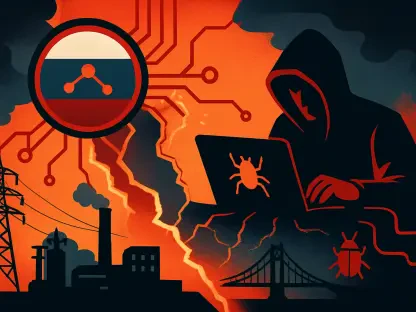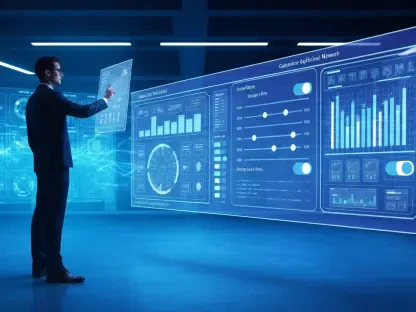In an era where digital connectivity defines the pace of progress, live video analytics has emerged as a game-changing force across multiple sectors, revolutionizing how organizations process real-time data to make informed decisions. This technology, powered by cutting-edge tools like artificial intelligence (AI) and machine learning (ML), enables instant analysis of video streams, offering insights that enhance security, optimize operations, and personalize user experiences. From bustling urban centers relying on surveillance for safety to streaming platforms tailoring content on the fly, the applications are as diverse as they are impactful. The market’s staggering growth, valued at USD 17.54 billion in 2023 and projected to reach USD 45.62 billion by 2032 with a compound annual growth rate (CAGR) of 11.2%, underscores its rising significance in a hyperconnected economy. As industries race to adapt to an ever-evolving digital landscape, this technology stands at the forefront, driving efficiency and innovation in ways previously unimaginable, setting the stage for a deeper exploration of its transformative potential.
Market Dynamics and Growth
Driving Forces Behind Adoption
The rapid adoption of live video analytics stems from an urgent need for real-time insights in a world where split-second decisions can define success or failure across industries. Businesses today face mounting pressure to respond instantly to dynamic conditions, whether it’s a retailer tracking customer behavior during a live event or a logistics firm monitoring fleet movements. The integration of AI, ML, and Internet of Things (IoT) technologies has significantly boosted the capabilities of these solutions, allowing for precise analysis and scalable deployment. This technological synergy not only enhances the speed of data processing but also ensures that insights are actionable, enabling organizations to stay ahead of the curve. Furthermore, the push for operational excellence in sectors like healthcare and education has fueled demand, as these fields increasingly rely on live feeds for remote interactions and monitoring, highlighting the critical role of analytics in modern workflows.
Another key driver is the growing emphasis on data-driven decision-making as a cornerstone of competitive strategy in a digital-first economy, where companies are leveraging live video analytics to uncover patterns and trends that would otherwise remain hidden in raw video data. This transforms passive observation into active intelligence. For instance, media platforms use real-time viewer feedback to adjust content dynamically, while security firms detect anomalies before they escalate into threats. The continuous evolution of supporting technologies, such as faster processors and improved algorithms, further accelerates adoption by making solutions more reliable and user-friendly. This momentum is complemented by a cultural shift toward embracing digital tools, as organizations recognize that staying relevant requires harnessing the power of instant analytics to navigate complex challenges and capitalize on emerging opportunities.
Regional Leadership and Infrastructure
North America, Europe, and Asia-Pacific have positioned themselves as leaders in the deployment of live video analytics, thanks to their advanced digital ecosystems and forward-thinking policies. These regions benefit from substantial investments in high-speed internet and 5G networks, which are essential for minimizing latency and supporting the seamless processing of high-definition video streams. Governments and private entities in these areas are also fostering innovation through partnerships that prioritize infrastructure development, ensuring that businesses have the bandwidth and tools needed to implement real-time analytics effectively. This robust foundation not only drives market growth but also attracts global tech leaders to establish hubs, further solidifying these regions as epicenters of technological advancement in this domain.
Beyond infrastructure, the leadership of these regions is reinforced by a skilled workforce and regulatory frameworks that encourage digital transformation while addressing security concerns. In North America, for example, policies promoting data privacy alongside innovation create a balanced environment for adoption, while Europe’s focus on standardization ensures interoperability across borders. Meanwhile, the Asia-Pacific region’s rapid urbanization and tech-savvy population drive demand for smart solutions in cities and industries alike. The synergy between public support and private investment in data centers and connectivity solutions creates fertile ground for live video analytics to thrive. This regional dominance illustrates how a combination of technological readiness and strategic vision can accelerate the integration of cutting-edge tools into everyday operations, shaping global trends in the process.
Industry-Specific Transformations
Media, Healthcare, and Education Impacts
In the realm of media and entertainment, live video analytics is redefining how content creators connect with audiences by providing real-time insights into viewer behavior during live streams. This technology allows platforms to adjust broadcasts instantly, tailoring content to maximize engagement and retention, whether it’s a sports event or a virtual concert. Beyond mere viewership metrics, the technology analyzes emotional responses and preferences, enabling a level of personalization that keeps audiences hooked. This dynamic adaptability is transforming the industry into a more responsive and interactive space, where user feedback shapes the experience as it unfolds, setting a new standard for digital entertainment in an era of endless content options.
Healthcare is another sector experiencing profound change through live video analytics, particularly in the expansion of telemedicine and remote diagnostics. Doctors can now conduct real-time consultations with patients across vast distances, supported by AI-driven tools that analyze video feeds for vital signs or symptoms during the session. This capability not only improves access to care in underserved areas but also enhances the accuracy of diagnoses through immediate data integration. Hospitals also use these solutions to manage digital patient records seamlessly, ensuring that critical information is updated instantly. The result is a more efficient healthcare system that prioritizes timely intervention, demonstrating how real-time analytics can bridge gaps in access and quality of medical services.
Education platforms have similarly embraced this technology to deliver interactive and engaging remote learning experiences, a trend that has become vital in recent years. Live video analytics helps educators monitor student participation and comprehension during virtual classes, allowing them to adjust teaching methods on the spot to address gaps in understanding. This adaptability ensures that learning remains effective despite physical distances, fostering inclusivity for students worldwide. Additionally, institutions leverage these tools to analyze long-term engagement trends, refining curricula to better suit diverse learner needs. This transformation underscores the potential of real-time analytics to create a more responsive educational environment, where technology empowers both teachers and students to thrive in a digital age.
Manufacturing and Public Safety Applications
In manufacturing, live video analytics plays a pivotal role in predictive maintenance, identifying potential equipment failures before they disrupt production lines. By analyzing video feeds from factory floors in real time, the technology detects subtle anomalies—such as unusual vibrations or wear patterns—that signal impending issues, allowing for proactive repairs. This minimizes costly downtime and optimizes supply chain efficiency, as manufacturers can schedule maintenance during non-peak hours. The ability to anticipate problems rather than react to them marks a significant shift toward smarter industrial operations, where data-driven foresight becomes a competitive advantage in an increasingly automated landscape.
Public safety is another critical area benefiting from live video analytics, particularly in enhancing surveillance and threat prevention in urban environments and critical infrastructure. Real-time analysis of video feeds enables authorities to detect suspicious activities or anomalies instantly, such as unauthorized access or unusual crowd behavior, triggering immediate responses to mitigate risks. This technology is instrumental in safeguarding public spaces, from airports to city centers, by providing a proactive layer of security that traditional methods cannot match. Moreover, integration with other systems, like facial recognition or traffic monitoring, amplifies its effectiveness, creating a comprehensive safety net. This application highlights how real-time insights can protect communities by staying one step ahead of potential dangers.
Beyond immediate threat detection, live video analytics supports long-term safety planning by analyzing historical data to identify patterns and vulnerabilities in public spaces. City planners and law enforcement agencies use these insights to allocate resources more effectively, such as increasing patrols in high-risk areas or redesigning infrastructure to reduce blind spots. This strategic approach not only prevents incidents but also builds public trust in safety measures, as communities see tangible improvements in security. The dual focus on real-time response and future preparedness illustrates the depth of impact this technology has on public safety, transforming it from a reactive field into a predictive and preventive one, capable of adapting to evolving challenges in complex urban settings.
Technological Innovations and Accessibility
Cutting-Edge Tools and Platforms
The performance of live video analytics has been significantly elevated by breakthroughs in edge computing and cloud-native architectures, which address the challenges of speed and scalability in processing vast video data streams. Edge computing, by processing data closer to its source, drastically reduces latency and bandwidth usage, ensuring that insights are delivered in real time even in high-demand scenarios like live events or security monitoring. This localized approach is crucial for applications where even a slight delay can compromise outcomes, offering a robust solution for industries requiring instantaneous feedback. As these technologies continue to mature, they pave the way for more seamless and reliable analytics, reinforcing the foundation for widespread adoption across diverse operational contexts.
Cloud-native platforms further enhance the capabilities of live video analytics by providing flexibility and scalability to handle fluctuating data volumes without performance hiccups. Organizations can dynamically adjust resources based on demand, ensuring cost-efficiency while maintaining high-quality analysis during peak usage periods, such as major public broadcasts or emergency situations. These platforms also facilitate integration with other digital tools, creating a cohesive ecosystem where video insights inform broader business strategies. The continuous improvement of cloud security measures adds another layer of trust, addressing concerns about data integrity in distributed environments. This combination of adaptability and robustness is driving innovation, making real-time video processing a cornerstone of modern technological infrastructure.
Bridging the Gap for SMEs
One of the most transformative aspects of live video analytics is its increasing accessibility to small and medium-sized enterprises (SMEs), largely due to the advent of affordable cloud-based solutions. Historically, the high costs and technical complexity of such advanced systems limited their use to large corporations with substantial budgets. Now, scalable platforms allow SMEs to tap into powerful analytics tools without the burden of heavy upfront investments, enabling a retailer to monitor customer interactions or a small logistics firm to track deliveries in real time. This shift not only boosts operational efficiency for smaller players but also fosters a more competitive market, as they can now rival larger entities with data-driven strategies tailored to their unique needs.
This democratization of technology is also supported by user-friendly interfaces and managed services that reduce the need for specialized in-house expertise among SMEs. Vendors are increasingly offering subscription-based models and pre-configured solutions, minimizing the learning curve and integration challenges for businesses with limited technical resources. As a result, SMEs can focus on leveraging insights rather than grappling with implementation, whether it’s enhancing customer service through live feedback or optimizing workflows with visual data. This inclusivity is narrowing the digital divide, empowering a broader range of businesses to participate in the global economy. The ripple effect of such accessibility is profound, as it drives innovation at the grassroots level, contributing to a more dynamic and resilient tech ecosystem.
Challenges and Barriers
Cost and Integration Hurdles
Despite its transformative potential, live video analytics faces significant obstacles in the form of high initial costs and complex integration processes, particularly for organizations with constrained budgets. Deploying these systems often requires substantial investment in hardware, software, and infrastructure upgrades, which can be prohibitive for smaller entities or those in developing markets. Additionally, integrating analytics solutions with existing workflows demands technical expertise and time, further straining resources. Many businesses struggle to justify the upfront expense when immediate returns are not guaranteed, creating a barrier to entry that slows broader market penetration and limits the technology’s reach across diverse sectors.
Compounding the financial challenge is a notable shortage of skilled professionals capable of implementing and maintaining advanced live video analytics systems. Organizations often find themselves competing for a limited pool of talent, driving up labor costs and delaying deployment timelines. Without adequate training or support, even well-funded companies may encounter inefficiencies or underutilization of their investments, as staff struggle to adapt to sophisticated tools. Addressing these hurdles will require innovative financing models, such as subsidies or partnerships, alongside educational initiatives to build a larger, more capable workforce. Overcoming these barriers is essential to ensure that the benefits of real-time analytics are not confined to a select few but are accessible to a wider array of industries and businesses.
Data Security and Compliance Concerns
The real-time nature of live video analytics introduces heightened risks of data breaches and privacy violations, making cybersecurity a paramount concern for organizations adopting this technology. Video streams often contain sensitive information, from personal identities in surveillance footage to proprietary processes in industrial settings, and any lapse in protection can lead to significant legal and reputational damage. As the volume of connected devices grows, so does the attack surface, requiring continuous investment in robust encryption, access controls, and threat detection systems. Balancing the need for instantaneous analysis with stringent security measures remains a critical challenge that shapes trust in these solutions across sectors.
Navigating the complex landscape of regulatory compliance adds another layer of difficulty, as requirements vary widely across regions and industries, creating a patchwork of obligations for global operations. In some areas, strict data protection laws demand explicit consent for video monitoring, while others prioritize national security over individual privacy, leading to conflicting priorities. Organizations must allocate resources to ensure adherence to these diverse standards, often requiring specialized legal and technical expertise to avoid penalties or operational disruptions. Developing standardized protocols and fostering international cooperation on data governance could alleviate these burdens, enabling smoother deployment while safeguarding user rights. Until such frameworks are in place, compliance will remain a significant obstacle to scaling live video analytics worldwide.
Future Horizons
Emerging Technologies and Opportunities
Looking ahead, the trajectory of live video analytics is poised for remarkable expansion, fueled by emerging technologies like quantum computing and metaverse applications that promise to redefine its capabilities. Quantum computing, with its potential to process data at unprecedented speeds, could revolutionize how video feeds are analyzed, enabling complex pattern recognition and predictive modeling in fractions of the time current systems require. Meanwhile, integration with metaverse environments opens up novel use cases, such as real-time behavioral analysis in virtual spaces for immersive training or entertainment. These advancements signal a future where the boundaries of live video analytics extend beyond traditional applications, creating opportunities in uncharted digital territories that could reshape entire industries.
The convergence of AI-driven automation with live video analytics is another frontier set to unlock transformative potential, particularly in enhancing decision-making precision across diverse scenarios. Automated systems could independently interpret video data to trigger responses—such as adjusting traffic flows in smart cities or optimizing energy usage in industrial plants—without human intervention, boosting efficiency on a massive scale. This evolution will likely spur innovation in areas like autonomous vehicles and personalized customer experiences, where split-second insights are paramount. As research and development in these fields accelerate, stakeholders can anticipate a wave of solutions that not only address current limitations but also anticipate future needs, positioning live video analytics as a cornerstone of next-generation technology ecosystems.
Policy Support and Global Trends
Government policies and private sector investments in key regions are expected to play a pivotal role in sustaining the momentum of live video analytics, ensuring its integration into broader digital transformation strategies. Supportive frameworks, such as subsidies for 5G infrastructure and incentives for tech adoption, are creating environments where businesses can experiment with and scale real-time solutions without prohibitive risks. In regions like North America and Europe, policies balancing innovation with data protection are fostering trust, while the Asia-Pacific region’s focus on smart city initiatives drives demand for analytics in urban planning. This alignment of public and private goals is critical for maintaining growth, as it addresses both technological and societal dimensions of adoption.
On a global scale, the emphasis on sustainable technology and smart mobility points to a future where live video analytics tackles pressing challenges like urbanization and environmental conservation. Applications in traffic optimization, resource management, and disaster response are already demonstrating how real-time insights can contribute to greener, more resilient communities. Cross-border digital trade, supported by harmonized data standards, represents another growth avenue, as businesses leverage analytics to streamline international operations. Reflecting on the strides made, it’s clear that strategic policy interventions and collaborative efforts in the past laid the groundwork for these advancements, ensuring that live video analytics evolved into a tool for global problem-solving and sustainable progress.









